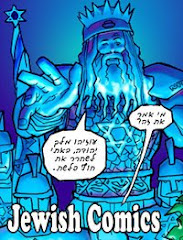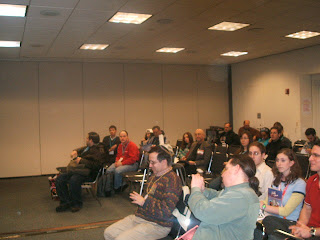I won't be attending this year's San Diego Comic Convention and there won't be a "Jewish Side of Comics" panel there this year.
The SDCCI (which starts tomorrow and has its preview night tonight) will have plenty of Jewish comics professionals in attendance, as well as some non-Jewish comics professionals who have done "Jewish" work and 6 sessions which I would specifically reccommend to those who will be there.
Among the guests in attendance will be :
*
Sergio Aragones (who illustrated the "Fanny Hillman : Jewish Madam" books and adapted the Jonah story for
Testament)
*
Dick Ayers (illustrator of "Lonely Are the Brave" in
Combat Kelly and the Deadly Dozen #2, in which the titular heroes liberate a concentration camp)
*
Kyle Baker (author-illustrator of the
King David graphic novel from Vertigo)
*
Mike Baron (illustrator of many
Nexus stories ; one of the main characters in
Nexus is Judah Maccabee aka "The Hammer")
* Brian Michael Bendis
*
Nick Bertozzi (illustrator of
Houdini : The Handcuff King* Bob Burden (author of the story "Behold the Golem" in
Gumby #2)
*
Peter David who infamously used the names of seder plate items for aliens in a Star Trek novel and who wrote the stories for
The Incredible Hulk #386-387 ; see
http://www.leaderslair.com/noexcuses/hulk2-386.html and http://www.leaderslair.com/noexcuses/hulk2-387.html)
*
Mark Evanier (author of a Crossfire story in which a Holocaust survivor tries to take revenge upon an actor he mistakenly thinks is a Nazi war criminal)
* Danny Fingeroth (author of
Disguised as Clark Kent : Jews, Comics, And the Creation of the Superhero)
* Gary Friedrich (author of "Lonely Are the Brave" in
Combat Kelly and the Deadly Dozen #2, in which the titular heroes liberate a concentration camp)
*
Neil Gaiman (Jewish author who retold a midrash on Adam's 2nd wife and had a Jewish musician meet Death in the pages of his
Sandman series)
*
Rick Geary (illustrator of the story "Behold the Golem" in
Gumby #2)
* Justin Gray (co-creator of the Monolith)
* Arie Kaplan (author of the
"Kings of Comics" series of articles in
Reform Judaism magazine)
*
Miriam Katin (author-illustrator of the autobiographical
We Are On Our Own)
* Scott Kurtz (author-illustrator of
PVP, the Eisner-award-winning online comic strip which last year made a joke about the
Superman Returns movie being "a Jewish conspiracy to convince Christians that Jesus was gay.")
* Stan Lee (Jewish comics legend who co-created the Fantastic Four, which has a Jewish chartacter called The Thing and who appeared in the story "What if the Original Marvel Bullpen was the Fantastic Four?" in
What If? #11)
* Paul Levitz (author of "Tradition" in DC Comics'
9-11 September 11th 2001)
*
Miriam Libicki (author-illustrator of the autobiographical
jobnik! series)
*
Rob Liefield (illustrator of stories in the
Youngblood series, which included the Israeli superheroine Masada)
*
Joseph Michael Lisner (illustrator of the story "Corporate Ladder" which appeared in the series
Cry for Dawn)
*
Todd McFarlane (co-plotter of the story "Remains" in
Spawn #103)
*
Jimmy Palmiotti (co-creator of the Monolith)
*
Paul Pope (author-illustrator of the "Berlin Batman" story in
Batman Chronicles #11)
*
Trina Robbins (co-author of "Zog Nit Keyn Mol : the Partisans Song" and author of "Th Trinagle Fire" which was published in both
Corporate Crime Comics #2 and
Lilith magazine #2)
*
Steve Rude (author of many
Nexus stories ; one of the main characters in
Nexus is Judah Maccabee aka "The Hammer")
* Gail Simone (who wrote the story "Li'l Krusty in Give a Hoot, Stay in School" in
Simpsons #62)
*
Cameron Stewart (illustrator of
Manhattan Guardian #1, in which the title character battles a golem)
*
JM Straczynski (author of the Spider-Man story "You Want Pants with That?" and the
Rising Stars story "Selah")
*
James Sturm (author-illustrator of
The Golem's Mighty Swing)
* Roy Thomas (who had the Thing battle the Golem in
Marvel Two-in-One #11 and introduced Jewish superheroes Nuklon {Infinity Inc. / JLA} and Golem {The Invaders})
*
Marv Wolfman (author of a
Tomb of Dracula story in which a Jewish man named Eshkol makes Dracula recoil with a Star of Daviod necklace, a
Teen Titans story which has a heroic Israeli soldier and the graphic history book
Homeland : The Illustrated History of the State of Israel)
Jewish / Israeli work that has been nominated for an Eisner award
*
Kramer's Ergot #6 (which is edited by Sammy Harkham and includes his story "Lubavitch, Ukraine 1876") is nominated for Best Anthology
*
Pizzeria Kamikaze (by Israelis
Etgar Keret and
Asaf Hanuka) is nominated for Best U.S. Edition of International Material
*
Joann Sfar (author-illustrator of the
Little Vampire books,
Vampire Loves,
The Rabbi's Cat and
Klezmer) is nominated for Best Writer / Artist
Notable Sessions* Fri., July 27th, Room 30AB
Disguised as Clark Kent: Jews, Comics, and the Creation of the Superhero —
Superheroes were created by Jews. Is that significant, or a complete coincidence and no big deal? In a reading from his provocative new Continuum book,
Disguised as Clark Kent: Jews, Comics, and the Creation of the Superhero, longtime Spider-Man editor and author of Superman on the Couch Danny Fingeroth explores the backgrounds of the young, largely Jewish men from Eastern European backgrounds who created the most well-known superheroes. Fingeroth will discuss how the creators' Jewish backgrounds may have helped make superheroes the most familiar popular culture icons of all—on TV, in movies, and in electronic media, as well as in comics.
Arie Kaplan will be a respondent at this session and will be signing his book
Masters of the Comic Book Universe Revealed! from 11:30-1:00.
* Fri., July 27, 1:30-2:30, Room 3
Spotlight on Miriam Katin -
Illustrator Miriam Katin's first graphic memoir,
We Are On Our Own, chronicled her escape from Nazi-held Budapest with her mother during World War II and debuted to national fanfare from magazines such as Time and People. Cartoonist and editor Shaenon K. Garrity will interview Miriam about her life and work.
* Fri., July 27, 2:30-3:30, Room 4
Legacy of Will Eisner -
Even after his death, Will Eisner's legacy continues with the same intensity that marked his long and remarkable career. A major motion picture adaptation of
The Spirit, new
Spirit comic books and archival collections from DC Comics, new collections of Eisner's influential graphic novels from W. W. Norton, theatrical adaptations, art exhibitions and a never-before-published textbook are among the many projects in the works. Discussing this wide range of activity are Will's widow Ann Eisner, writer/artist Darwyn Cooke (DC Comics's
Will Eisner's The Spirit), and movie producers Michael Uslan and Deborah Del Prete. Moderated by Eisner's long-time publisher and art and literary agent Denis Kitchen.
* Sat., July 28, 10:30-11:30, Room 10
Spirituality In Comics —
Spiritual themes weave a significant pattern in the story arc of our comics’ worlds. Hear from distinguished guests Doug TenNapel (
Creature Tech), Holly Golightly (
School Bites), Miriam Libicki (Real Gone Girl Studios,
jobnik!), Christine Kerrick (
Soul Trappers), and Leo Partible (
Behind the Screen: Insiders on Faith). Moderated by Scott A. Shuford (Christian Comic Arts Society).
* Sun., July 29, 10:30-11:45, Room 1AB
Jack Kirby Tribute —
Let’s face it: when it comes to comics, it’s Kirby’s World and we just live in it. 2007 has seen a bumper crop of Kirby projects, including the first volume of DC’s deluxe chronological reprinting of all the Fourth World stories, a major documentary about Jack on the
Fantastic Four DVD, and Mark Evanier’s upcoming art book
Kirby, King of Comics. Join Evanier as he talks to Neil Gaiman, Erik Larsen, Darwyn Cooke, Mike Royer, and members of the Kirby family about the lasting influence of the undisputed King of comics.
* Sun., July 29, 12:00-1:00, Room 30AB
Comics Arts Conference Session #14: Wolf Gal and the Feral Women of Li’l Abner —
Cartoonist and historian Trina Robbins (
From Girls to Grrrlz) presents a slideshow talk on the feral girls—Pig Girl, Hawk Girl, and Wolf Gal—of Li’l Abner’s Dogpatch, a bloodthirsty lot with no compunction about turning Dogpatchers into dinner. Wolf Gal, the starring wild girl of Dogpatch, is strong, beautiful, independent, and—don’t laugh—a feminist. When the little girls of Dogpatch imitate Wolf Gal by taking no guff from the boys, the citizens of Dogpatch react. They want their daughters to grow up as "overworked, wore-out, respectable married drudges," not "wild an' happy an'f ree, like th' wolf gal!!" Robbins connects these cartoon wild women with mythical feral children and more contemporary figures like Misha Defonseca, a Jewish orphan during World War II, who hid from the Nazis in the forests of occupied Europe for four years and eventually teamed up with a family of wolves. Recounting her experiences years later, she wrote, "the only time I ever slept deeply was when I was with wolves... Those were the most beautiful days I had ever experienced."














